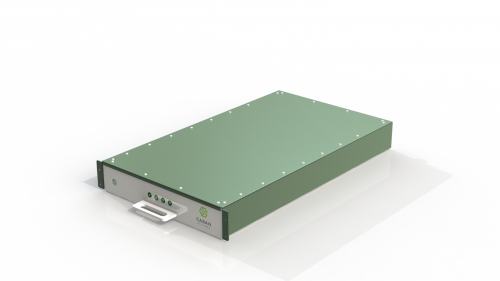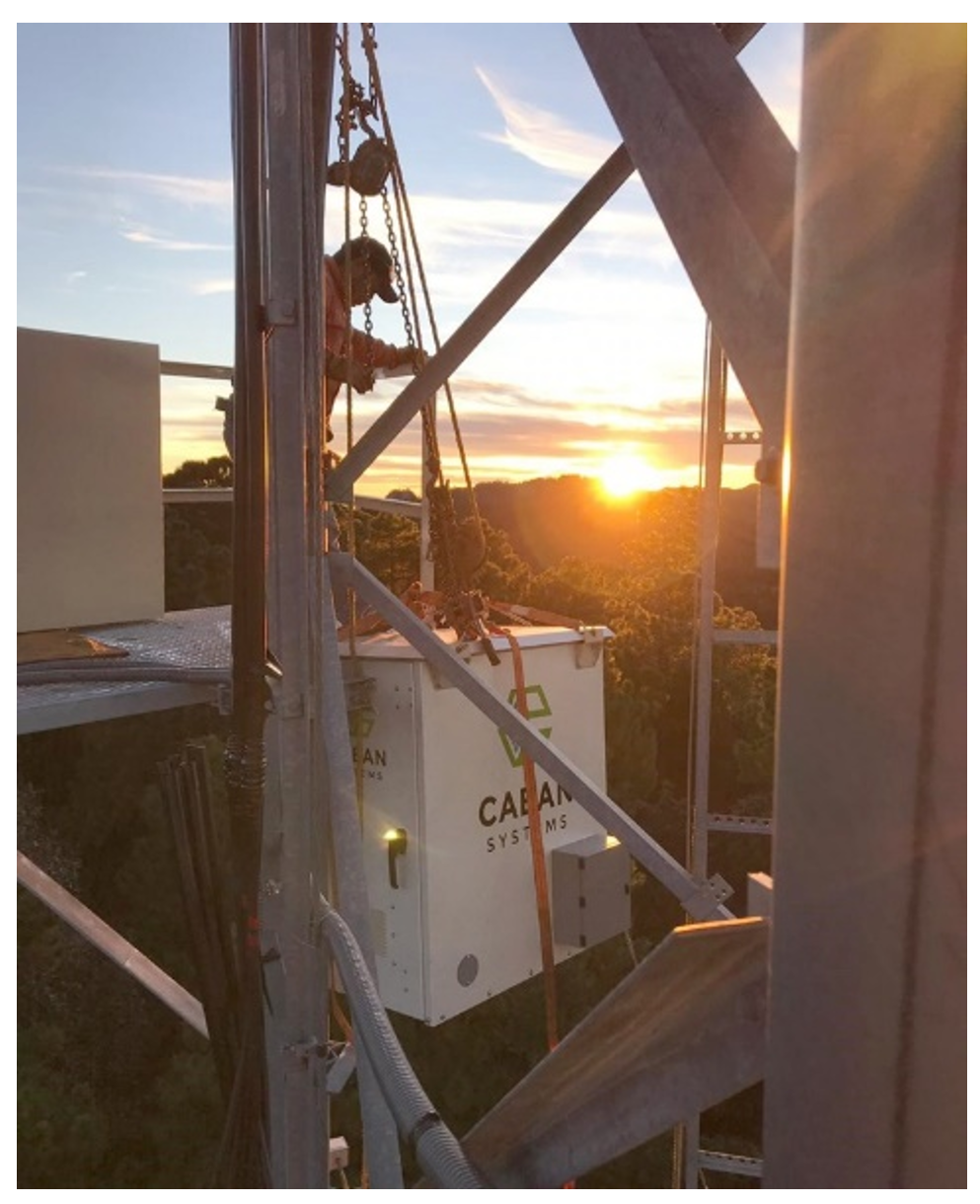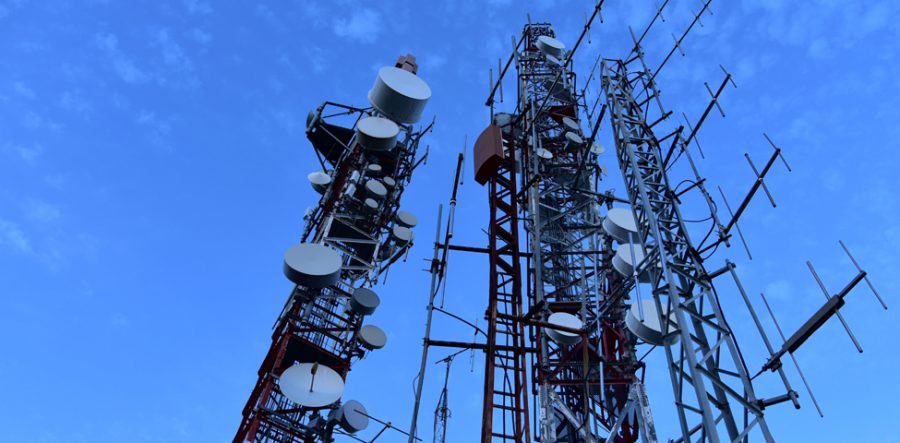Caban Systems: How intelligent power solutions can optimise the powering of communications
Executive Summary
Since the change in regulation permitting the collocation of multiple mobile network operators on a single site, operators have had to search for energy-dense solutions to decrease the area footprint taken by power assets. Until recently, energy and power technology lagged behind the speed of innovation with most sites resorting to one diesel generator per mobile network operator, leading to multifaceted inefficiencies. In addition, the use of diesel is inefficient and cost-prohibitive in comparison to newer renewable energy alternatives. Caban Systems introduces an intelligent power solution – a power system, capable of being powered solely through renewable energy, equipped with DC power metering, allowing for multiple operators to be powered from a central point.
This case study from Caban Systems focuses on how the challenges and optimisation of powering communication infrastructure can be solved with intelligent power solutions.
Caban Systems uses a power system built from ultra-dense lithium-ion packs, capable of providing standalone power for any telecommunication site, even off-grid sites in remote areas. The power solution is cloud-connected, equipped with multitenant energy tracking, allowing exact energy usage to be correlated with individual operators. Sites with multiple operators can now be powered from one central system. This results in not only a more efficient use of assets but efficient use of energy in general. In addition to the more efficient use of energy, Caban’s ultra-dense packs allow off-grid sites to be powered fully from renewable energy, reducing OPEX considerably.
Caban’s power solution is suitable for any geographic market, but it is most impactful for customers in markets with the electric grid and network infrastructure that is mostly currently in development (Country profile D: Developing, low urban). For areas with developing grid infrastructure, outage risks are high and having a diesel generator paired with a lead-acid battery backup becomes non-negotiable.
1. Introduction
For the millions of telecom sites worldwide located off-grid or in areas with an unreliable grid, depending on diesel generators and lead-acid batteries has been the traditional means of generating reliable power. With recent developments in alternative energy technologies and increasing fuel prices, this dependence now makes little economic sense. Vandalism, high costs from fuel transport, and frequent maintenance are costly. As the use of mobile data exponentially increases, cost-effective, on-site power generation and energy storage is essential. Caban Systems designs and manufactures software-enabled lithium-ion energy storage systems with dense battery packs. Combining them with cloud-connectivity results in a solution that is more cost-effective, remotely monitorable, and outlasts existing power delivery solutions.
Caban Systems was founded in Silicon Valley, the epicentre of innovation in renewable energy and storage technology. Caban focuses on power delivery on telecommunication sites to meet the growing needs of the industry. The world is growing increasingly more reliant on network connectivity, and the introduction of 5G increases the number of sites by an order of magnitude. Reliable, cost-effective, and clean power delivery will be a centrepiece of the next era in the telecommunication industry. Caban seeks to help the industry meet those challenges. The company is headquartered in northern California with offices in Mexico and Guatemala.
Founded by senior engineers from the electric automotive space, Caban Systems’ core team comes from leading battery systems manufacturers and system integrators such as Tesla, Siemens, A123, and Proterra. The team has over 70+ years of combined industry experience in designing, manufacturing, and deploying lithium-ion storage systems for a wide variety of applications across numerous industries, including automotive, consumer electronics, and grid-scale storage. The team drew upon their experience from key aspects across each sector – the flexibility in an automotive battery system to buffer the unpredictability that comes with powering a vehicle in traffic and changing road conditions, the safety of consumer battery systems embedded in devices that are carried around by individuals almost 100% of the day, and the reliability of grid-scale systems that deliver power to large populations. Combining essential prior industry experiences, Caban Systems created a best-in-class solution for powering critical telecommunication infrastructure.

Photo 1: A bad-grid powered by Caban Systems in the Dominican Republican.
2. Business Imperative
Caban’s power solution increases energy efficiency and introduces infrastructure sharing for power delivery equipment on telecommunication sites. Traditionally, off-grid telecommunication sites are powered by diesel generators and lead-acid starting batteries. High costs for diesel fuel and delivery, and frequent maintenance makes generators cost-prohibitive in many ways. While lead-acid batteries have also been dependable sources of power in cases of outages, they have a short cycle life and lack the energy density to be a standalone power source.
Also, despite being in close enough physical proximity to receive power from one generation source, typically operators collocated on one site are each required to have their own diesel generator, lead-acid battery, and set of power assets.
3. Caban System’s Solutions
Caban Systems introduces a power system built from ultra-dense lithium-ion battery packs, capable of providing standalone power for any telecommunication site, but specialising in bad/off-grid sites in remote areas. The power solution is AI-enabled and, equipped with multitenant energy tracking, allowing precise energy consumption to be monitored and shared with individual operators in real-time. Sites with multiple operators can now be powered from one central system, simplifying and improving communication. This results in not only a more efficient use of assets but also an efficient use of energy as well. In addition to energy efficiency, Caban’s ultra-dense packs allow off-grid sites to be powered fully from renewable energy, reducing OPEX considerably.

Photo 2: Caban Systems’ cabinet contains lithium-ion storage, a site controller, DC output, rectifiers and AC input (for on-grid), and telemetry in one solution.
Caban’s power solution is also modular in design. Battery packs can be stacked to scale up in power and energy storage capacity. Other key components can be interchanged to uniquely suit the needs of sites with varying environmental conditions.

Photo 3: Caban’s proprietary PowerPack, which allows for custom sizing and system redundancy.
4. The Need to Innovate
The telecommunications industry is ripe for innovation. It’s an industry that has seen little change in power technology in over 20 years since the transition from dial-up to high-speed internet. Through years of extensive industry experience, the founding team of Caban Systems realised deficiencies and inefficiencies with existing solutions and engineered a new power solution meeting several core requirements.
DC Metering
DC metering allows Caban’s energy solution to meter several discrete loads. Caban’s proprietary DC power meter samples the supply voltages and currents at regular intervals and along with the sampling period. A computational energy model accurately tracks the energy and charges the customer for the energy used. Caban’s power solution becomes the perfect complement to the collocation model of telecommunication sites, meeting the infrastructure sharing needs of the onsite operators. Currently, many sites solve this problem by having each customer operate their energy equipment – for example, 3 operators will have three generators serving each. Caban’s solution can power all three tenants from a single cabinet, avoiding the cost of unnecessary equipment.
Intelligent Management
Critical data points are sent to the cloud at regular intervals to offer real-time updates and alerts for fault prevention, theft, and alarms. Bi-directional communication is an essential feature for DC metering to allow operators to receive accurate billing and forecasting of their unique energy profile. After extensive market research, the founders of Caban Systems found that augmenting existing battery technology for specific cloud-connectivity in a manner that met the demands of a telecommunication site presented significant difficulties. They determined it was necessary to design a proprietary system from the ground up. Caban Systems’ proprietary machine learning algorithms power the management software platform combined with intuitive interface design, predictions and alert systems.
Vertical Integration
Difficult logistical coordination between multiple parties leads to limited engineering support and importation challenges with existing solution providers. Caban created a proprietary site controller to manage all power assets on-site, and thereby reduce risks associated with integration, logistics, and supply chain customers.
Ability to Offer EaaS (Energy-as-a-Service)
Existing power setups make inefficient use of space and result in unnecessary costs for an operator housed on the site. The Caban team realised that a power solution that correlated energy usage to each operator would make more efficient use of energy and benefit both the tower company and the mobile network operators. Offering energy as a paid service simplified operations for the operators. Furthermore, by applying Caban’s advanced machine learning algorithms, tower companies can offer a clean power and intelligent solution with increased energy efficiency.
5. Economic Benefits
Through increased energy efficiency and the innovative ability to provide infrastructure sharing of power assets, Caban’s power solution significantly reduces the annual power costs for a given telecommunication site. When measured over the conservatively estimated lifetime of Caban’s systems (10 years), the OPEX portion with regards to power is reduced on average by 72%.
There are numerous factors behind the savings realised by the power solution from Caban Systems. There are numerous factors behind the savings realised by the power solution from Caban Systems.
Providing Reliable & Clean Power:
- Ability to combine standalone power and backup power – Caban’s ultra-dense battery packs; allows its solution to be the sole power source for a telecommunications site. The different functions of a starting battery, diesel generator, and backup battery are now provided by one power system.
- Ability to be powered by 100% renewable power – Because Caban’s power solutions are powerful enough to be the sole source of power for a site, an opportunity for the site to be powered entirely by renewable energy is now feasible. Issues with intermittency exist for renewable sources such as wind and solar; however, Caban designs systems to buffer this expected intermittency with SLAs up to 98%.
- Reduction of diesel use (for hybrid systems) – If the site requires a hybrid power solution where the battery system is coupled with a diesel generator, there will still be a considerable reduction in the use of diesel fuel. Running diesel generators 24 hours a day, seven days a week leads to inefficient use of diesel fuel and also shortens the lifespan of the generator. Generators run most efficiently at 80-90% load. The electric load profile of a telecommunication site fluctuates throughout the day. Coupling a generator with a battery system from Caban makes the most efficient use of the fuel and gives the generator the necessary downtime. The battery system is the primary supplier of energy, and the generator turns on only to recharge the battery.
Simplified Operations
- Reduction of diesel transport – Existing solutions for getting diesel to the telecommunication sites are cost-prohibitive. Storing diesel onsite requires proper containment to meet safety requirements but is frequently disallowed due to the risks posed by onsite diesel. Regular transport of diesel to sites becomes too costly, especially for sites in remote areas. Typically, this can cost an additional US$0.50-$1.00 per gallon of diesel, depending on location.
- Reduction in required real estate for power assets – Instead of needing each operator onsite to be equipped with a diesel generator and lead-acid battery, all operators can share Caban’s power solution that centralises the delivery of power from a single source. Caban’s power solution takes the equivalent space of a single generator set.
Cost & Maintenance Reduction
- Reduction in maintenance costs – Caban’s power solution requires roughly 7% of the regular maintenance that is necessary for a diesel generator and lead-acid combination. With reductions in maintenance frequency, operators can reduce the frequency of their site visits, resulting in significant savings.
- Reduction in site visits – Caban’s power solution further reduces the number of required site visits by providing remote monitoring through the cloud software.
- Vandalism-proof – Caban’s power systems are enclosed with a rugged exterior and equipped with sensors for remote monitoring. Data regarding the surrounding environment is sent to the cloud, and the software alerts operators of any abnormal activity in real-time. The lithium-ion cells are unusable outside of the systems and have no practical market value.
- Reduction in the frequency of battery replacements – A typical lead-acid battery has an average life span of 2 years. Caban has designed battery systems that have a warranty of 10-years and no visible capacity fade. The payback period for Caban’s energy platform ranges from 6 months to 3 years on the longer end compared with current technologies for a capital purchase, and immediate savings with EaaS.
New Revenues and New Value
Cost savings is the most significant value proposition provided by Caban’s power solution. However, Caban provides several ancillary benefits as well. Instead of leaving operators on the site to purchase their own backup power equipment, tower companies can now offer energy as an added service. The offer is enticing because it shifts a typical CAPEX to OPEX and allows the operators to buffer changing market conditions.
6. Implementing the Solution
Each telecommunication site is different. That is precisely why Caban’s power solution is designed with modularity, not only to allow for scaling in power and capacity needs but also for other vital components to accurately match variations in environmental conditions. The process to procure a system is simple and starts with a site survey. This is primarily conducted remotely with Caban’s digital site assessment solution. After conducting the site assessment, the operator provides a digital visualisation of the power solution customised for the site. Manufacturing and assembly typically take 4-6 weeks. Installation of the system is done onsite with local certified installers. Installation is quick and takes only a single day. The system can be integrated easily into the existing infrastructure. The Caban team provides comprehensive training for using cloud software. The onsite power system follows a simple design from traditional power systems and is intuitively usable. After the power system is up and running, the local certified installers provide ongoing support for the system onsite. Software updates are automatic, and support is provided from the Caban team directly through the platform.
Caban’s power solution is suitable for any geographic market, and it is most impactful for customers in markets with the electric grid and network infrastructure that is mostly currently in development. This includes countries in Africa, Central America, South America, and parts of Asia, North America, and the Middle East. For areas with developing grid infrastructure, outage risks are high and having a diesel generator paired with a lead-acid battery backup becomes non-negotiable. Caban’s power solution is the most cost-effective solution to cover backup power and standalone power needs. Allowing operators to share power assets is a bonus and also increases cost-effectiveness.
Commercialisation and Current Implementations
The company has active deployments with many of the most established players in the industry, such as Phoenix Tower International, Telefonica, and SBA. Caban’s first commercial pilot deployment was installed in November of 2018 – this remote off-grid site reaches summer of 110 degrees F in summer and winter of 20 degrees F in winter. The team at Caban knew it was an opportunity to demonstrate the capability and reliability of its power solution to the fullest extent. The critical infrastructure has been receiving uninterrupted power since install with only minimal routine maintenance done remotely by Caban engineers.
Caban’s power solutions have received 100% acceptance by the pilot customers thus far. Caban is currently working with existing customers and new customers across Latin America, North America and the Middle East to deploy power systems on telecommunication sites worldwide.
7. Challenges and Lessons Learned
The difficult transportation and lodging logistics of installing on remote locations present the most significant challenge. The team at Caban has determined that the process needs to be front-loaded with extensive planning before arriving onsite to ensure the installation crew has a vehicle packed with all the necessary pieces of equipment. To better streamline and sequence the tasks onsite, the team should gauge as much about the site conditions as possible beforehand., thereby reducing the time spent on site and prevents any additional trips to gather other pieces of equipment.

Photo 4: A Caban cabinet being installed on a tower in Durango, Mexico.
8. Conclusion
Energy networks are vital to reliable and effective communications. As the world grows more dependent on data and internet access, the demand for cost-effective and reliable power delivery increases. With more than 3.5M cell towers across the globe, 40% still depend on expensive diesel and outdated power systems. Caban’s founders innovated to create the smarter alternative an intelligent power solution – one power system that allows multiple operators housed on a site to be powered from one central system, equipped with remote monitoring and control. Cost savings, new revenues, and unique value all realised with a straightforward solution.
